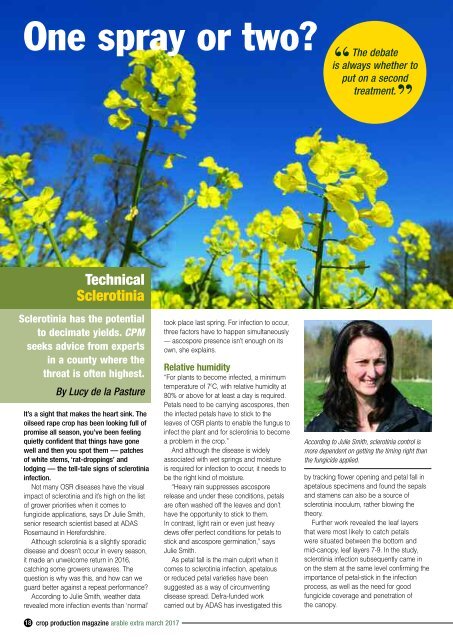In this issue..
CPM-March-Extra-2017
CPM-March-Extra-2017
Create successful ePaper yourself
Turn your PDF publications into a flip-book with our unique Google optimized e-Paper software.
One spray or two?<br />
“<br />
The debate<br />
is always whether to<br />
put on a second<br />
treatment. ”<br />
Technical<br />
Sclerotinia<br />
Sclerotinia has the potential<br />
to decimate yields. CPM<br />
seeks advice from experts<br />
in a county where the<br />
threat is often highest.<br />
By Lucy de la Pasture<br />
It’s a sight that makes the heart sink. The<br />
oilseed rape crop has been looking full of<br />
promise all season, you’ve been feeling<br />
quietly confident that things have gone<br />
well and then you spot them –– patches<br />
of white stems, ‘rat-droppings’ and<br />
lodging –– the tell-tale signs of sclerotinia<br />
infection.<br />
Not many OSR diseases have the visual<br />
impact of sclerotinia and it’s high on the list<br />
of grower priorities when it comes to<br />
fungicide applications, says Dr Julie Smith,<br />
senior research scientist based at ADAS<br />
Rosemaund in Herefordshire.<br />
Although sclerotinia is a slightly sporadic<br />
disease and doesn’t occur in every season,<br />
it made an unwelcome return in 2016,<br />
catching some growers unawares. The<br />
question is why was <strong>this</strong>, and how can we<br />
guard better against a repeat performance?<br />
According to Julie Smith, weather data<br />
revealed more infection events than ‘normal’<br />
took place last spring. For infection to occur,<br />
three factors have to happen simultaneously<br />
–– ascospore presence isn’t enough on its<br />
own, she explains.<br />
Relative humidity<br />
“For plants to become infected, a minimum<br />
temperature of 7 0 C, with relative humidity at<br />
80% or above for at least a day is required.<br />
Petals need to be carrying ascospores, then<br />
the infected petals have to stick to the<br />
leaves of OSR plants to enable the fungus to<br />
infect the plant and for sclerotinia to become<br />
a problem in the crop.”<br />
And although the disease is widely<br />
associated with wet springs and moisture<br />
is required for infection to occur, it needs to<br />
be the right kind of moisture.<br />
“Heavy rain suppresses ascospore<br />
release and under these conditions, petals<br />
are often washed off the leaves and don’t<br />
have the opportunity to stick to them.<br />
<strong>In</strong> contrast, light rain or even just heavy<br />
dews offer perfect conditions for petals to<br />
stick and ascospore germination,” says<br />
Julie Smith.<br />
As petal fall is the main culprit when it<br />
comes to sclerotinia infection, apetalous<br />
or reduced petal varieties have been<br />
suggested as a way of circumventing<br />
disease spread. Defra-funded work<br />
carried out by ADAS has investigated <strong>this</strong><br />
According to Julie Smith, sclerotinia control is<br />
more dependent on getting the timing right than<br />
the fungicide applied.<br />
by tracking flower opening and petal fall in<br />
apetalous specimens and found the sepals<br />
and stamens can also be a source of<br />
sclerotinia inoculum, rather blowing the<br />
theory.<br />
Further work revealed the leaf layers<br />
that were most likely to catch petals<br />
were situated between the bottom and<br />
mid-canopy, leaf layers 7-9. <strong>In</strong> the study,<br />
sclerotinia infection subsequently came in<br />
on the stem at the same level confirming the<br />
importance of petal-stick in the infection<br />
process, as well as the need for good<br />
fungicide coverage and penetration of<br />
the canopy.<br />
18 crop production magazine arable extra march 2017


